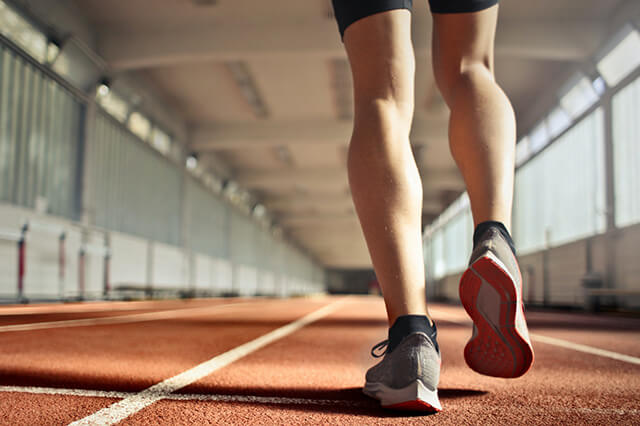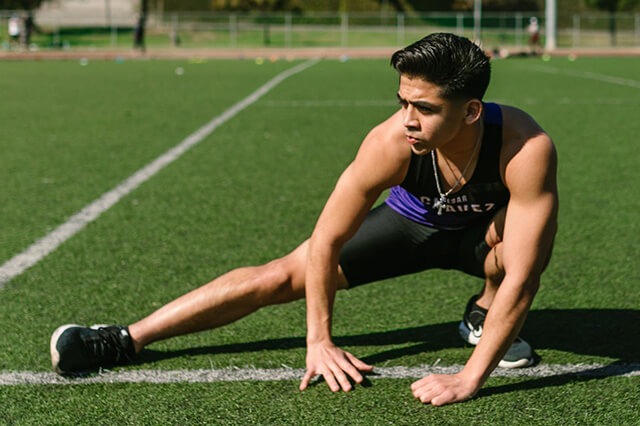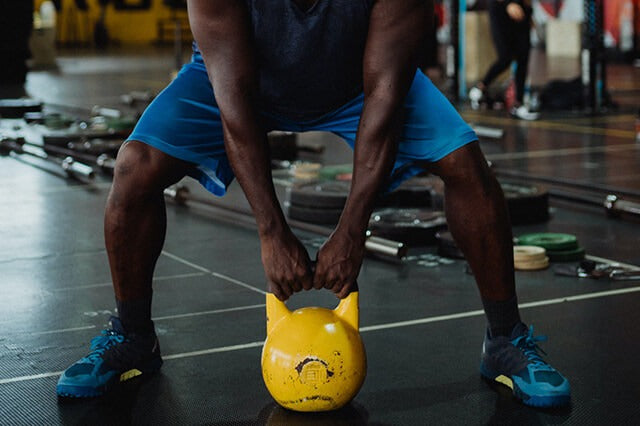Our legs are the foundation of our body. After all, they support our weight throughout the day as we take several steps, climb stairs or simply stand. Strong lower extremities are therefore not only required for sports. Shapely upper and lower legs play an important role, especially in women's world. For many women they are actually the problem area.
Is it any wonder that firm thighs and strong calves have now become the ideal of beauty? Muscle training for the lower extremities is the key to well-formed proportions. We clarify which exercises are ideal, whether stretching is necessary after strength training and what benefits taking amino acids can bring in this process.
The basics: Why bother with the leg muscles at all?
Did you know that the thighs and lower legs, together with the buttocks, form the largest contiguous muscle group in the human body? From a purely functional point of view, they act as a unit both in everyday life and during sport. A unit that can only be as strong as its weakest link. For this reason alone , regular leg training is recommended .
With pure endurance training such as jogging, cycling, etc. However, it is not done here. Endurance training increases the endurance capacity of the muscles, but hardly contributes to strength development. The same applies to the formation of the muscles. And that is precisely the goal of leg training for many women.
5 good reasons for leg training
Before we start with specific training tips, we want to emphasize the importance of muscle training for the lower extremities.
The following arguments speak for themselves:
1. Form follows function
Translated into German, this means nothing more than “ form follows function ”. But what does this mean in terms of strength training? Quite simply : the muscles of the human body adapt in their shape to the function they have to fulfill in everyday life. Take a look at the difference between a marathon runner and a sprinter.
The sprinter has strong upper and lower legs as well as a well-shaped bottom. The marathon runner, on the other hand, usually appears gaunt and wiry. The causes are the different stress patterns. While the marathon runner trains her muscles for endurance for hours, the sprinter focuses on strength and speed.
Different types of muscle fibers are responsible for the development of these properties. These are genetically predetermined to a certain extent. However, through targeted training you can push your muscles in the direction you want.

2. Muscles shape the body:
An aesthetic body image with well-shaped proportions is the goal of many women. Hardly anything can be achieved by simply reducing body fat through diets. The muscles are what give your body the shape you want. Without a well-developed muscle chain from butt to calf , any diet is largely useless in this regard. If you want to achieve your dream figure, rely on muscle training.
3. Muscle training supports diet success:
Every gram of muscle you build burns additional energy. This also increases your personal calorie consumption without you having to limit your food intake. This even works at rest, while you are sitting in the car, lying on the couch or sleeping. Lower body training in particular is extremely important for the body to use more energy. After all , just one leg makes up a large part of the body's total muscles.
4. Muscle training helps with sporting ambitions:
Are you an endurance athlete and want to improve your performance? Strengthening training is also the method of choice here. Strength training has a huge benefit for runners . This is the only way to optimally train all the muscle fibers in the leg. As you know, every chain is only as strong as its weakest link. The bottom line is that you gain strength endurance and speed through targeted muscle training . This can lead to a significant increase in performance both on inclines and at high speeds.
5. Strong muscles protect the musculoskeletal system:
As women get older, they tend to lose bone structure (osteoporosis). If a fall or other accident occurs, the likelihood of broken bones increases. Well-trained leg muscles can prevent many falls and trips before they happen. And should a fall occur, the muscles protect bones, joints and ligaments from damage.

How often should I train my legs?
This is often the sticking point. Many women train their lower extremities too often because they want to achieve their dream body. But here you end up in a trap.
Because if you often put a lot of strain on your muscles without sufficient breaks, you ensure two things:
-
You end up overtraining . This means that your muscles don't have time to recover. This minimizes the possible muscle building. At the same time, this overload increases the risk of injury in the long term.
- Through constant strain, you are not training your muscles formuscle growth (hypertrophy), but rather for endurance. The result : Performance may increase somewhat, but visually there will be little change in terms of body shaping.
To achieve maximum success, you need to give your muscles time to recover and grow. It is often incorrectly assumed that a muscle grows during exercise. The opposite is the case. After a strain, the damaged muscles must first regenerate to their original level.
Only then does new tissue build up. Depending on the training intensity, give your muscles a break of at least 48 hours. 72 hours between two training sessions is better. The bottom line is that it works out to two to three training sessions per week .
Attention : After heavy training sessions with severe muscle soreness, the regeneration time can easily be 96 hours.
Tip : Three to four sets of 8-12 repetitions per exercise are ideal for building muscle. If you want to focus particularly onclimbing training or strength training for runners, increase the repetition range to 15 to 25 repetitions per set. You train more for strength endurance. Adjust the training weight so that you do not do more than the maximum number of repetitions per set.
Which sport helps with fat legs?
Experience has shown that this is a question that concerns many women . However, there is no one-size-fits-all answer to this simple question, and certainly not a simple one. First of all, we would like to emphasize that from a physiological point of view it is not possible to specifically lose body fat in individual parts of the body using specific exercises.
Don't let miracle training programs and products mislead you here. The key to shapely legs lies in the combination of exercise and a consistent diet to reduce body fat. While building muscle gives your body the desired contour, melting away fat deposits ensures that the contours come to light.
To get back to the original question:
Any sport that you do regularly and combine it with an adapted diet helps. Activities that strengthen the bottom, thighs and calves at the same time are ideal. From cycling to cross-country running and rowing to tennis and climbing training, the possibilities are huge. In addition, there is muscle training with specific exercises.
How can amino acids support leg training?
Whether strength training without equipment , with equipment, running, climbing or rowing . Those who do sports demand significantly more from their bodies than people who do not do sports. Think of it like a racing car. This also has to meet higher requirements and therefore requires special support.
What special engine oil and high-quality fuel are to racing cars is nutrition to the human body. It is therefore important to ensure that you eat a balanced and, above all, protein-rich diet. The daily protein intake for beginners should be at least 0.8 to 1.1 grams per kilogram of body weight per day.
For advanced athletes, the requirement increases to up to 2 grams per day/kilogram of body weight in order to achieve ideal muscle building . This increased need is often difficult to cover with solid food. If this is also the case for you, protein products and amino acids are ideal.
Above all, it is advisable to take additional BCAA products during high physical strain. These contain the amino acids L-leucine, L-isoleucine and L-valine, which the organism increasingly needs. The Federal Institute for Risk Assessment speaks of a dosage of up to 8.2 grams of BCAA per day, which can be consumed in addition to food.
Strength training legs: Get into practice!
No matter whether strength training without equipment or with equipment - the exercise options are enormous. Accordingly, we would like to introduce you to the most effective exercises that you can do in the gym or for strength training at home .
Leg training with dumbbells and machines
If you train in the gym or have some training equipment available at home, you can best train your upper and lower legs. The goal should always be to activate the entire muscle chain. In this way, you simultaneously promote the interaction between the individual muscles.
This so-called intermuscular coordination promotes the development of strength, stability, economy of movement and coordination. For this reason , leg training exercises should be as complex as possible.
The following exercises are ideal:
1. Barbell squat
The squat with the barbell is the classic leg training exercise . Since it is a so-called free exercise, numerous other muscle groups are involved in addition to the legs. Including the back, shoulders and abdominal muscles. Important: Before you train with heavy weights, you must internalize the technique! Otherwise the risk of injury is high. It is important, among other things, that your back is straight at all times and that your knees do not protrude past your toes.
2. Dumbbell squat
For anyone starting strength training at home or in the studio, the dumbbell squat is an easier entry-level variation. This is because the weight does not rest on the neck, but is held parallel to the upper body in the form of two dumbbells in both hands. The lower center of gravity makes it much easier to maintain balance during training . The focus of the load is on the buttocks and the outer strands of the leg extensor (quadriceps femoris).

3. Front squat
When doing a front squat, the bar is not behind your neck, but rather on your breastbone. This slight shift in the center of gravity means that the thigh extensor on the front of the leg has to work significantly more. The exercise is therefore ideal for developing a characteristic muscle structure. Just like with the barbell squat, you should first learn the technique here.
4. Deadlifts
The deadlift is the most complex leg training exercise . It addresses a large part of the entire body muscles and promotes muscle building and general performance. Deadlifts should not be missed as preparation for climbing training or strength training for runners. Attention : The exercise is highly complex and if performed incorrectly, injuries can quickly occur. Therefore, start with a low weight and internalize the technique. However, when done correctly, there is hardly a more effective exercise.
5. Lunges
You can perform classic lunges with either a barbell, two dumbbells or a kettlebell. Due to the wide stretching during the movement, the gluteal muscles in particular are activated in addition to the back area of the thigh. You can make the exercise even more challenging by placing the front leg on a step, training bench or box.
6. Leg press
The leg press is available in different forms in fitness studios. By using different pressure angles and foot positions, other muscle areas can be targeted. Since the device guides the movement, the leg press is particularly suitable for beginners . This way you can build up a certain amount of basic strength for more complex exercises. Later, guided exercises on machines should only serve as a supplement.
7. Adduction & abduction on the device
The inside and outside of the thighs are much more difficult to activate with classic exercises. The masters of creation in particular often neglect training in these extremely important areas. Most women here are smarter and used the machines provided in the gym for adduction and abduction movements. Remember what we said: Every chain is only as strong as its weakest link. Weak adductors or abductors can lead to knee and foot misalignments.
Tip : Put together a training plan of three to four exercises to train your buttocks, thighs and lower legs in as varied a way as possible. After a few weeks, it is also advisable to replace individual exercises with others. This way you always provide new training and growth stimuli.

Strength training legs at home - train effectively with simple means
Is strength training possible effectively without equipment? But it certainly is. Comprehensive leg training can also be easily implemented in your own four walls.
We would like to provide you with some examples:
-
Squats with a backpack : If you don't have dumbbells at hand, you don't have to miss out on squats. A large backpack that you fill with water bottles or sand before training is sufficient. Everything is possible, from the classic squat to the sumo squat.
-
Single-leg exercise execution : Is an exercise not demanding enough for you despite the additional weight? Then do squats or calf raises on one leg. This not only increases the strain on the target muscles, but also promotes coordination and stability.
-
Use your stairs : A staircase is an ideal training device for training lunges. The more stairs you climb in one step, the more challenging the exercise is. Here too you can work with additional weight. Stairs or steps and boxes are also suitable for other exercises such as calf raises.
-
Misusing household items : Are you missing the training equipment for deadlifts etc.? Then you are misusing heavy household items. How about a full water crate as a barbell replacement for deadlifts or water bottles as an alternative to dumbbells?
-
Training bands : Strength training without equipment can be made much more effective by using training bands. You increase the resistance of every exercise through dynamic pulling. At the same time, they allow you to do exercises when training at home that are otherwise only possible with dumbbells.
Important : Light stretching is part of every muscle training session. However, massive stretching after strength training is not necessary and is even counterproductive. Excessive stretching after strength training can cause the damaged muscle structure to become even more affected. This extends the regeneration time.

Conclusion: strength training legs
Do you finally want a firm bottom and toned thighs? Do you want to improve your endurance sports or just get fitter in your everyday life? Then you now know how you can tackle this problem with targeted muscle training and a protein-rich diet . Get started today because effective training is possible both at home and in the gym.




